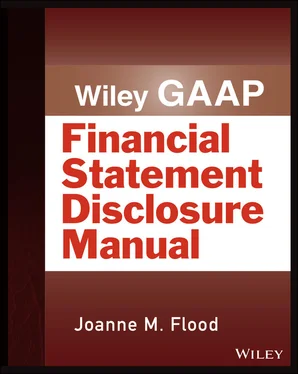Full Set of Financial StatementsA full set of financial statements consists of:
1 Financial position at the end of the period.
2 Earnings (net income), which may be shown in a separate statement or within one continuous statement of comprehensive income.
3 Comprehensive income for the period in one statement or two consecutive statements.
4 Cash flows during the period.
5 Investments by and distributions to the owners during the period.(ASC 205‐10‐45‐1A)
Order of DataThe order of data is not prescribed. However, for tabular information, it is good practice to present information by year with the most current year appearing consistently in either the first or last column.
Changes Affecting ComparabilityComparative information should be consistent. Any exceptions to comparability must be disclosed as a reclassification, and accounting change, or correction of an error, as described in ASC 250. (ASC 205‐10‐45‐3) To the extent they remain significant, notes to financial statements should be repeated in comparative statements or at least referred to. (ASC 205‐10‐45‐4 and 50‐2)
PresentationHere are the presentation items required for GAAP:
Include name of entity for which statements are being presented (if d/b/a is different name from legal name, indicate both).
Titles of statements should be appropriate (certain titles denote and should be reserved for GAAP financial statements; other titles denote other comprehensive basis of accounting [OCBOA] financial statements).
Dates and periods covered should be clearly stated.
If comparative statements are presented, repeat or at least refer to notes from prior years to the extent they continue to be significant. (FASB ASC 205‐10‐45‐4 and 50‐2)
Differences between “economic” entity and legal entity being presented should be noted (e.g., consolidated or not, subsidiaries included and excluded, combined statements, etc.). Disclose summarized financial information for previously unconsolidated subsidiaries.
DisclosureThere is only one required disclosure for this subsection listed in the Codification:
For reclassifications or other reasons, if changes have occurred in the manner or basis of presenting corresponding items in two or more periods, disclose the explanation of the change. (FASB ASC 205‐10‐50‐1)
ASC 205‐20, Discontinued Operations
Determining When a Disposal Should Be Presented as a Discontinued OperationThe unit of account for a discontinued operation is:
A component of an entity,
A group of components of an entity, or
A business or nonprofit entity.(ASC 205‐20‐45‐1A)
The guidance describes a discontinued operation as a disposal of a component, group of components, or an entity that:
Represents a strategic shift that has (or will have) a major effect on an entity's operations and financial results.and
Is:disposed of by sale,meets the criteria to be classified as held for sale, ordisposed of by other than sale (for example by abandonment, exchange, or distribution to owner).(ASC 205‐20‐45‐1B)
The guidance goes on to state that a strategic shift could include:
A major geographical area of operations,
A major line of business,
A major equity method investment, or
Other major parts of an entity.(ASC 205‐20‐45‐1C)
A component is classified as held for sale when all of the following criteria are met:
Management has the authority to approve and commits to a plan to sell.
The component is available for immediate sale.
Management has initiated a program to complete the plan to sell.
A buyer is being actively sought.
The sale is probable.
The transfer will qualify for recognition as a completed sale within one year.
The sale price being marketed is reasonable.
It is unlikely that the plan to sell will not be withdrawn or undergo significant changes unless the limited exceptions under ASC 205‐20‐45‐1G are met.(ASC 205‐20‐44‐1E and ASC 360‐010‐45‐9)
Presentation—Income StatementA discontinued operation is reported as such in the period in which the discontinued operation has been disposed of by sale or other means or is classified as held for sale. (ASC 205‐20‐45‐3)
| In the period in which a component of an entity is reported as a discontinued operation: |
| Item |
Presentation |
| Results of operations of that component |
Report as a separate component of income, net of tax, before the cumulative effect of accounting changes. (ASC 205‐20‐45‐1B and 45‐3A) |
| Any gain or loss recognized on disposal or loss recognized on classification as held for sale |
Report separately on the face of the income statement or disclose in the notes. (ASC 205‐20‐45‐3B and 205‐20‐50‐1b) |
| The income statements of any prior periods being presented |
Restate to also reflect the results of operations of the component as discontinued operations. (ASC 205‐20‐45‐3) |
Gain or loss is calculated based on guidance in other Topics. For example, if the discontinued operation is within the scope of ASC 360, Property, Plant, and Equipment , guidance can be found in that Topic. (ASC 205‐20‐45‐3C)
The following types of debt should be allocated to discontinued operations:
Interest on debt assumed by the buyer.
Interest on debt required to be repaid as a result.(ASC 205‐20‐45‐6)
In subsequent periods, adjustments to amounts previously reported may be needed because, for example, of resolution of contingencies related to disposal or operations of the discontinued business or settlement of employee benefit obligations. If adjustments are needed, they should be presented separately in the discontinued operations section where income is reported. (ASC 205‐20‐45‐4 and 45‐5 and 50‐3A)
Presentation—Balance SheetThe assets and liabilities of a disposal group must be presented separately, and not offset, on the face of the balance sheet or by reference in the notes. When the discontinued operation is initially classified as held for sale and from prior periods presented, the major classes of assets and liabilities should be disclosed on the face of the statement of financial position or in the notes. (FASB ASC 205‐10‐45‐10 and 45‐11) and the entity does not have to reclassify previously reported amounts.
Disclosures for Assets Sold or Held for SaleFor all types of discontinued operations, disclosures include:
For periods in which a discontinued operation has been disposed of or is classified as held‐for‐sale:The facts and circumstances leading to the disposal or expected disposal;The expected manner and timing of the disposal;If not separately presented on the face of the income statement as part of discontinued operations, gain or loss recognized on the disposal or loss recognized on classification as held for sale in accordance with the relevant guidance in other subtopics; andThe segment in which the discontinued operation is reported under Topic 280.(FASB ASC 205‐20‐50‐1)
Change to a Plan of SaleIf an entity changes its plan of sale, in the period in which that decision is made, it must disclose in the notes:
The facts and circumstances leading to the decision.
The effect of the change on the results of operations for all periods presented.(FASB ASC 205‐20‐50‐3)
The nature and amount of adjustments to amounts previously reported in discontinued operations directly related to discontinued operations.(FASB ASC 205‐20‐50‐3A)
Читать дальше












